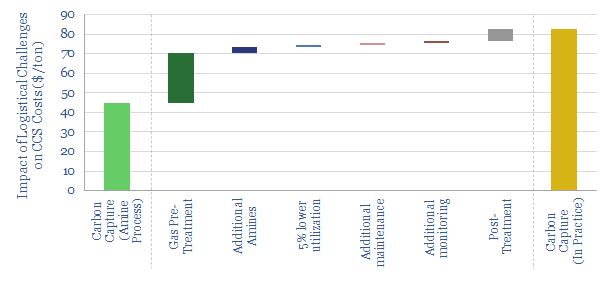Post-combustion CCS has more practical challenges than we had previously assumed, as are explored in this 13-page report. Today’s established amines require extensive pre- and post-treatment of gases; to prevent degradation, plant corrosion and toxic emissions. This might double real-world CCS costs. But it also creates more opportunity for novel CCS processes, which are rapidly emerging.
CCS denotes any energy technology that prevents CO2 from combustion (or calcining) being released into the atmosphere. Our latest roadmap to net zero assumes 6 GTpa of CCS by 2050, of which one half, or 3 GTpa is conventional CCS. Data are given for the costs and energy penalties of conventional CCS — spanning across amine plants, CO2 pipelines, CO2 trucks, CO2 shipping and CO2 disposal — on page 2.
What now? Conventional CCS is likely to accelerate, due to reforms to the 45Q, in the US Inflation Reduction Act of 2022. Forecasts for the market’s evolution (in MTpa) are summarized on page 3.
As a result, practical and logistical issues are moving into view. Chief among them is whether conventional CCS actually works well in practice? How does it work? And are there hidden CCS challenges, which have not been tackled by 40MTpa of historical CCS projects? (pages 4-5).
Amine degradation lies at the root of these CCS challenges. Make-up rates for amines can be quantified from technical papers (data here). But these studies also show wide variability, and offer up useful data that will matter for real world installations.
CCS challenges. Seven challenges for commercial scale deployment of conventional CCS are presented on pages 7-10. We think lab studies under-estimate degradation rates, amine make-up processes will dent utilization, other operational parameters degrade alongside the amines, degraded amines corrode amine plants and equipment, they can result in toxic air emissions (nitrosamines are a possible show-stopper), especially where CCS plants are run intermittently, and all of the issues above can be highly sensitive to the impurities in the feed gases (SOx, NOx, particulates, etc, data here).
It is important to quantify and to understand these various CCS challenges, in order to risk CCS deployments appropriately. Or, conversely, to de-risk them.
Next-generation amines are being developed to overcome these challenges. The most mature example to cross our screen is profiled on page 11 (listed company), and seven further examples are profiled on page 12 (mainly private/venture companies).
Other abatement options. We had previously hoped that simple CCS would accelerate rapidly from 2023 onwards. However, there is a risk that today’s technically ready amine plants face more CCS challenges than anticipated, while many next-gen amines that overcome these challenges are not fully technically ready. This also makes us wonder whether there is more upside for other abatement options in the world’s roadmap to net zero (page 13).
